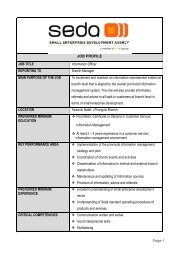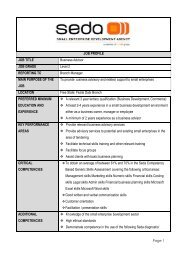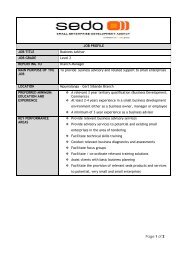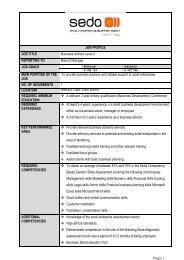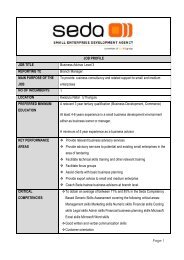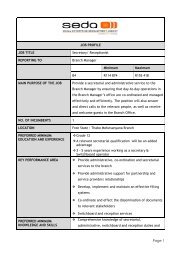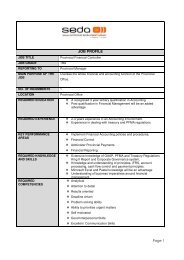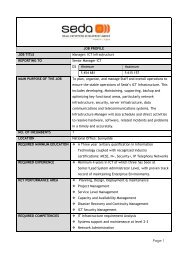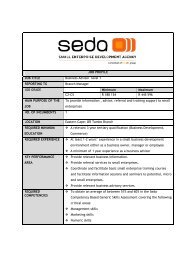Assessment of Cooperatives in the Poultry Industry - 2013.pdf - Seda
Assessment of Cooperatives in the Poultry Industry - 2013.pdf - Seda
Assessment of Cooperatives in the Poultry Industry - 2013.pdf - Seda
Create successful ePaper yourself
Turn your PDF publications into a flip-book with our unique Google optimized e-Paper software.
Research Report: Address<strong>in</strong>g <strong>the</strong> Needs, Opportunities and Challenges <strong>of</strong> <strong>Cooperatives</strong><br />
and Collectively Owned Enterprises <strong>in</strong> <strong>the</strong> <strong>Poultry</strong> and Related Industries<br />
Tra<strong>in</strong><strong>in</strong>g and development have been found to be key constra<strong>in</strong>ts to smallholder cooperatives. Lack<br />
<strong>of</strong> pr<strong>of</strong>essional and qualified managers is also a challenge fac<strong>in</strong>g cooperatives (Department <strong>of</strong><br />
Agriculture, Forestry and Fisheries, 2012).<br />
Membership <strong>in</strong> cooperatives is, <strong>in</strong> many cases, constituted by <strong>the</strong> elderly who have <strong>the</strong> will to<br />
produce, but lack <strong>the</strong> necessary skills and modern methods to produce. This cont<strong>in</strong>uously weakens<br />
management, governance and bus<strong>in</strong>ess skills <strong>in</strong> cooperatives. Inability to attract young pr<strong>of</strong>essionals<br />
compounds <strong>the</strong> capacity problems <strong>in</strong> smallholder cooperatives.<br />
The commission on tra<strong>in</strong><strong>in</strong>g and capacity build<strong>in</strong>g was facilitated by Ms Kwathi Koka <strong>of</strong> SEDA. While<br />
acknowledg<strong>in</strong>g <strong>the</strong> contribution <strong>of</strong> tra<strong>in</strong><strong>in</strong>g and capacity build<strong>in</strong>g <strong>in</strong> ensur<strong>in</strong>g effective management<br />
<strong>of</strong> smallholder cooperatives, this commission also noted <strong>the</strong> challenges fac<strong>in</strong>g smallholder<br />
cooperatives which <strong>in</strong>clude <strong>the</strong> follow<strong>in</strong>g:<br />
<br />
<br />
<br />
<br />
<strong>the</strong> low literacy levels <strong>of</strong> cooperatives members<br />
age<br />
lack <strong>of</strong> management skills<br />
lack <strong>of</strong> commitment by cooperatives members<br />
Many <strong>of</strong> <strong>the</strong>se concerns have been identified from <strong>the</strong> survey above and are confirmed by this<br />
research. A brief identification <strong>of</strong> <strong>the</strong> causes for term<strong>in</strong>ation <strong>of</strong> cooperatives (below) also illustrates a<br />
prevalence <strong>of</strong> membership concerns.<br />
4.1.3.<br />
Non-Operational <strong>Cooperatives</strong><br />
The cooperatives contacted for <strong>the</strong> survey <strong>in</strong>cluded both operational and non-operational<br />
cooperatives. A total <strong>of</strong> 40 cooperatives from <strong>the</strong> database were reachable, with <strong>the</strong> data from <strong>the</strong><br />
28 operational cooperatives be<strong>in</strong>g analysed above. The rema<strong>in</strong><strong>in</strong>g 12 <strong>of</strong> <strong>the</strong>se cooperatives are no<br />
longer operational. The <strong>in</strong>-operational cooperatives did, however, provide some background on <strong>the</strong>ir<br />
cooperatives and <strong>the</strong> ma<strong>in</strong> reasons for <strong>the</strong> failure <strong>of</strong> <strong>the</strong>ir bus<strong>in</strong>esses. This allows an alternative<br />
perspective on <strong>the</strong> challenges faced by cooperatives <strong>in</strong> <strong>the</strong> poultry <strong>in</strong>dustry.<br />
Similarly to what has been identified <strong>in</strong> <strong>the</strong> results above, many <strong>of</strong> <strong>the</strong> non-operational cooperatives<br />
stated that <strong>the</strong>y were not able to get <strong>the</strong>ir bus<strong>in</strong>ess <strong>of</strong>f <strong>the</strong> ground, due to a lack <strong>of</strong> equipment and<br />
<strong>in</strong>frastructure. Figure 4-20 below identifies <strong>the</strong> reasons cooperatives provided for <strong>the</strong> failure <strong>of</strong> <strong>the</strong>ir<br />
bus<strong>in</strong>ess.<br />
67 | P a g e U r b a n - E c o n : D e v e l o p m e n t E c o n o m i s t s



